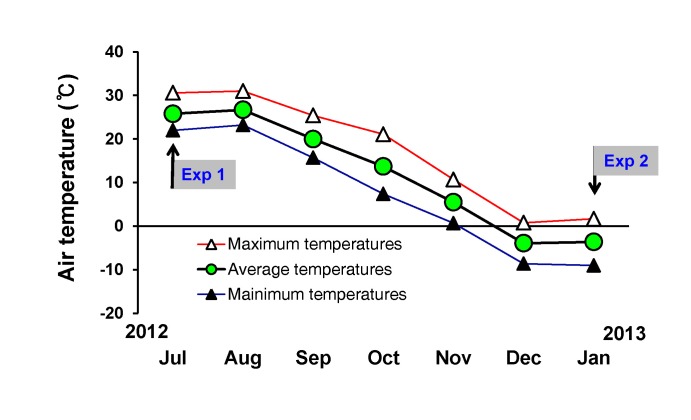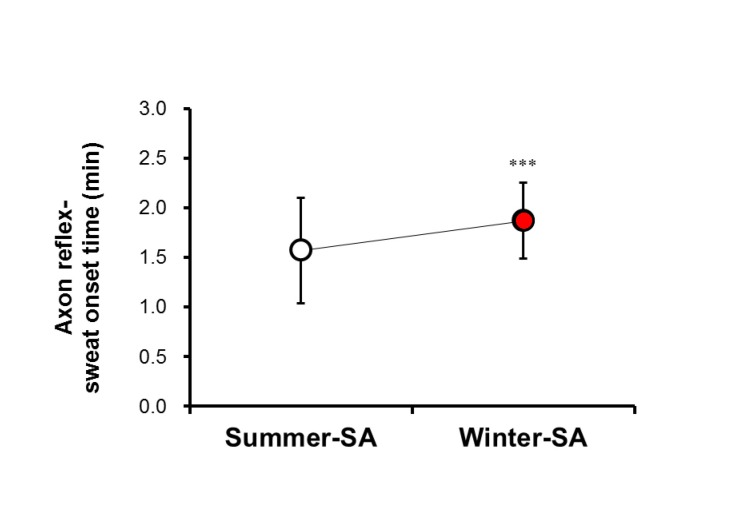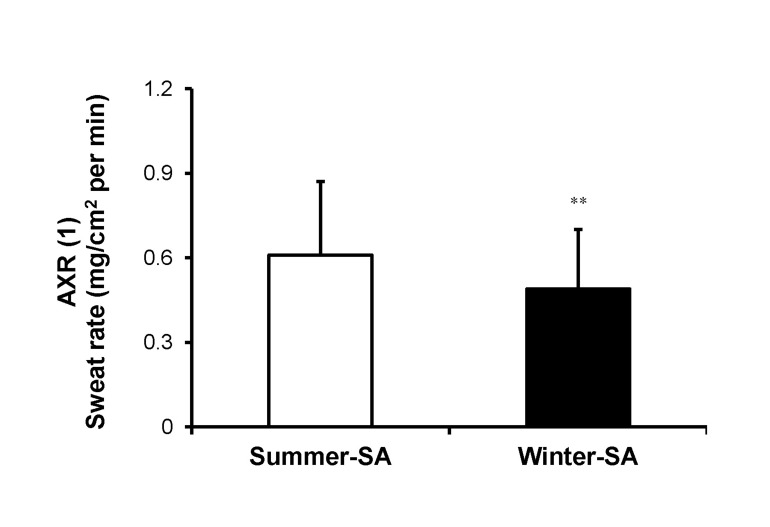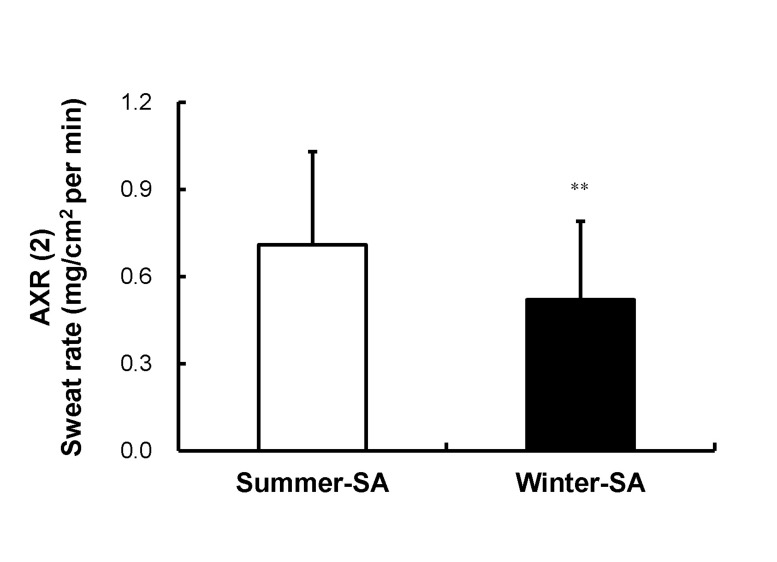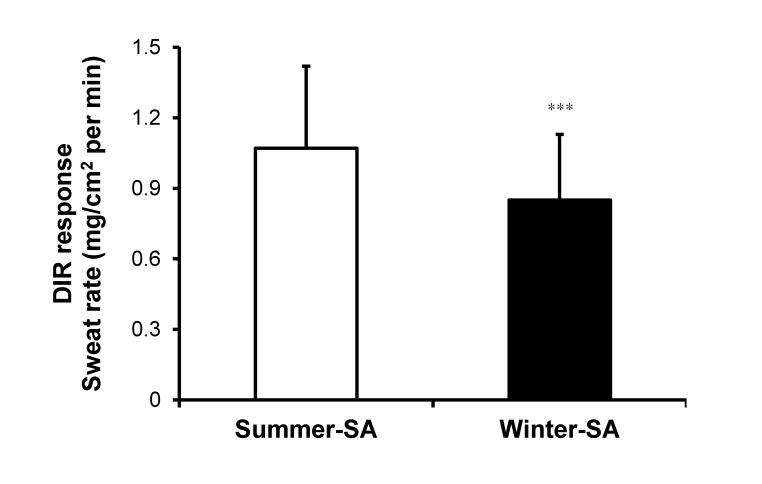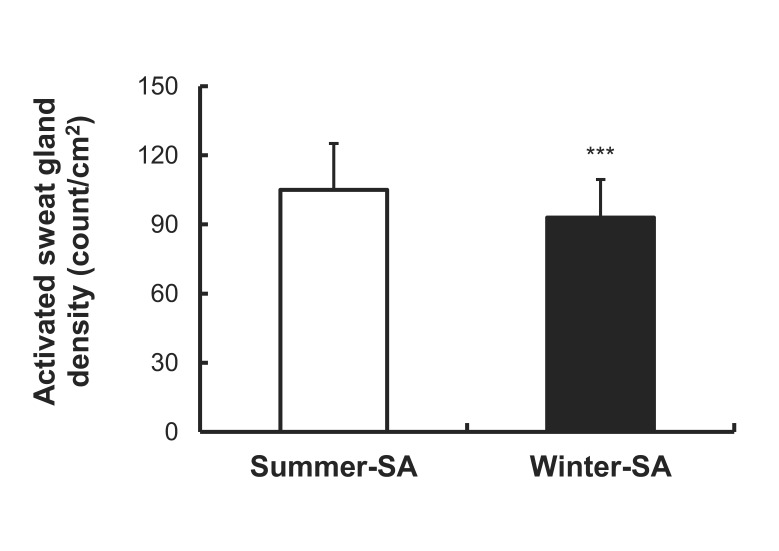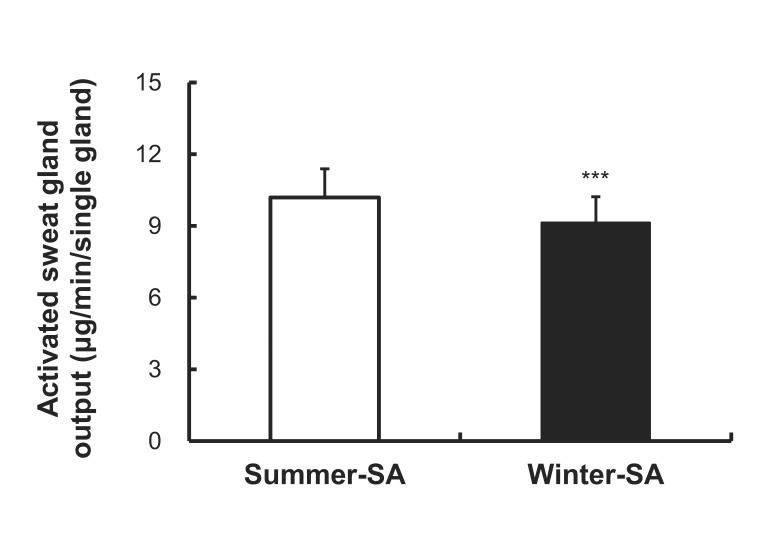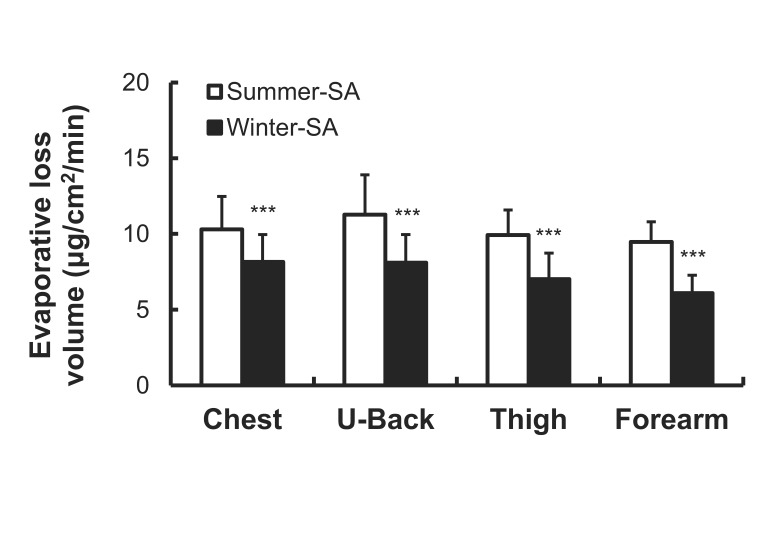Korean J Physiol Pharmacol.
2016 Sep;20(5):499-505. 10.4196/kjpp.2016.20.5.499.
Seasonal acclimation in sudomotor function evaluated by QSART in healthy humans
- Affiliations
-
- 1Department of Physiology, College of Medicine, Soonchunhyang University, Cheonan 31151, Korea. leejb@sch.ac.kr
- KMID: 2350506
- DOI: http://doi.org/10.4196/kjpp.2016.20.5.499
Abstract
- The quantitative sudomotor axon reflex testing (QSART) is a classic test of routine postganglionic sudomotor function. We investigated sudomotor function by QSART after summer (July 2012) and winter (January 2013) seasonal acclimation (SA) in the Republic of Korea. QSART with acetylcholine (ACh) iontophoresis were performed to determine directly activated (DIR) and axon reflex-mediated (AXR1, 2) sweating rate. Onset time of axon reflex, activated sweat gland density (ASGD), activated sweat gland output (ASGO), tympanic and skin temperatures (T(ty), T(sk)), basal metabolic rate (BMR), and evaporative loss volume changes were measured. Tympanic and mean body temperature (T(b); calculated from T(ty), T(sk)) were significantly lower after summer-SA than that of winter-SA. Sweat onset time was delayed during winter-SA compared to that after summer-SA. BMR, AXR(1), AXR(2), and DIR sweat rates, ASGD and ASGO, and evaporative loss volume were significantly diminished after winter-SA relative to after summer-SA. In conclusion, changes in sweating activity measured by QSART confirmed the involvement of the peripheral nervous system in variation of sudomotor activity in seasonal acclimation.
Keyword
MeSH Terms
Figure
Reference
-
1. Nadel ER, Pandolf KB, Roberts MF, Stolwijk JA. Mechanisms of thermal acclimation to exercise and heat. J Appl Physiol. 1974; 37:515–520. PMID: 4414615.
Article2. Lee JB, Matsumoto T, Othman T, Kosaka M. Suppression of the sweat gland sensitivity to acetylcholine applied iontophoretically in tropical Africans compared to temperate Japanese. Trop Med. 1997; 39:111–121.3. Griefahn B. Acclimation to three different hot climates with equivalent wet bulb globe temperatures. Ergonomics. 1997; 40:223–234. PMID: 9118933.
Article4. Li X, Tokura H, Midorikawa T. The effects of two different types of clothing on seasonal warm acclimatization. Int J Biometeorol. 1995; 38:111–115. PMID: 7744523.
Article5. Nielsen B. Heat acclimation--mechanisms of adaptation to exercise in the heat. Int J Sports Med. 1998; 19(Suppl 2):S154–S156. PMID: 9694425.6. Ogawa T, Sugenoya J. Pulsatile sweating and sympathetic sudomotor activity. Jpn J Physiol. 1993; 43:275–289. PMID: 8230848.
Article7. Nielsen B, Hales JR, Strange S, Christensen NJ, Warberg J, Saltin B. Human circulatory and thermoregulatory adaptations with heat acclimation and exercise in a hot, dry environment. J Physiol. 1993; 460:467–485. PMID: 8487204.
Article8. Williams CG, Wyndham CH, Morrison JF. Rate of loss of acclimatization in summer and winter. J Appl Physiol. 1967; 22:21–26. PMID: 6017648.
Article9. Hori S, Tanaka N. Adaptive changes in physiological responses of men to heat induced by heat acclimatization and physical training. Jpn J Trop Med Hyg. 1993; 21:193–199.
Article10. Matsumoto T, Kosaka M, Yamaguchi M, Nakamura K, Yang GJ, Amador JJ. Seasonal variation of thermal sweating. Trop Med. 1990; 32:73–80.11. Warwick PM, Busby R. Influence of mild cold on 24 h energy expenditure in 'normally' clothed adults. Br J Nutr. 1990; 63:481–488. PMID: 2383527.
Article12. Plasqui G, Kester AD, Westerterp KR. Seasonal variation in sleeping metabolic rate, thyroid activity, and leptin. Am J Physiol Endocrinol Metab. 2003; 285:E338–E343. PMID: 12857676.13. Horowitz M. Heat acclimation: a continuum of process. In : Mercer J, editor. Thermal Physiology. Amsterdam: Elsevier Science Publishers B.V;1989.14. Lee JB, Kim TW, Shin YO, Min YK, Yang HM. Effect of the heat-exposure on peripheral sudomotor activity including the density of active sweat glands and single sweat gland output. Korean J Physiol Pharmacol. 2010; 14:273–278. PMID: 21165324.
Article15. Vetrugno R, Liguori R, Cortelli P, Montagna P. Sympathetic skin response: basic mechanisms and clinical applications. Clin Auton Res. 2003; 13:256–270. PMID: 12955550.16. Lee JB, Bae JS, Matsumoto T, Yang HM, Min YK. Tropical malaysians and temperate koreans exhibit significant differences in sweating sensitivity in response to iontophoretically administered acetylcholine. Int J Biometeorol. 2009; 53:149–157. PMID: 19048305.
Article17. Shibasaki M, Inoue Y, Kondo N. Mechanisms of underdeveloped sweating responses in prepubertal boys. Eur J Appl Physiol Occup Physiol. 1997; 76:340–345. PMID: 9349649.
Article18. Sugenoya J, Ogawa T. Characteristics of central sudomotor mechanism estimated by frequency of sweat expulsions. Jpn J Physiol. 1985; 35:783–794. PMID: 4079134.
Article19. Chen WY, Elizondo RS. Peripheral modification of thermoregulatory function during heat acclimation. J Appl Physiol. 1974; 37:367–373. PMID: 4370254.
Article20. Ogawa T, Asayama M, Miyagawa T. Effects of sweat gland training by repeated local heating. Jpn J Physiol. 1982; 32:971–981. PMID: 7169703.
Article21. Lee JB, Kim TW, Min YK, Yang HM. Seasonal acclimatization in summer versus winter to changes in the sweating response during passive heating in korean young adult men. Korean J Physiol Pharmacol. 2015; 19:9–14. PMID: 25605991.
Article22. Du Bois D, Du Bois EF. Clinical calorimetry: tenth paper a formula to estimate the approximate surface area if height and weight be known. Arch Intern Med. 1916; XVII(6_2):863–871.23. Lee JB, Lee IH, Shin YO, Min YK, Yang HM. Age-and sex-related differences in sudomotor function evaluated by the quantitative sudomotor axon reflex test(QSART) in healthy humans. Clin Exp Pharmacol Physiol. 2014; 41:392–399. PMID: 24684442.24. Ramanathan NL. A new weighting system for mean surface temperature of the human body. J Appl Physiol. 1964; 19:531–533. PMID: 14173555.
Article25. Pinnagoda J, Tupker RA, Agner T, Serup J. Guidelines for transepidermal water loss (TEWL) measurement. A report from the standardization group of the european society of contact dermatitis. Contact Dermatitis. 1990; 22:164–178. PMID: 2335090.27. Kuno Y. Human perspiration. Springfield: Thomas;1956.28. Pandolf KB. Time course of heat acclimation and its decay. Int J Sports Med. 1998; 19(Suppl 2):S157–S160. PMID: 9694426.
Article29. Sawka MN, Wenger CB. Thermoregulatory responses to acute exercise heat stress and heat acclimation. In : Sawka MN, Wenger CB, Pandolf KB, editors. Comprehensive Physiology. 1996.30. Kim TW, Shin YO, Lee JB, Min YK, Yang HM. Caffeine increases sweating sensitivity via changes in sudomotor activity during physical loading. J Med Food. 2011; 14:1448–1455. PMID: 21883004.
Article31. Lind AR, Bass DE. Optimal exposure time for development of acclimatization to heat. Fed Proc. 1963; 22:704–708. PMID: 13930724.32. Pandolf KB, Burse RL, Goldman RF. Role of physical fitness in heat acclimatisation, decay and reinduction. Ergonomics. 1977; 20:399–408. PMID: 908323.
Article33. Armstrong LE, Maresh CM. The induction and decay of heat acclimatisation in trained athletes. Sports Med. 1991; 12:302–312. PMID: 1763248.
Article34. Taylor NA. Eccrine sweat glands. Adaptations to physical training and heat acclimation. Sports Med. 1986; 3:387–397. PMID: 3538269.35. Sato F, Owen M, Matthes R, Sato K, Gisolfi CV. Functional and morphological changes in the eccrine sweat gland with heat acclimation. J Appl Physiol(1985). 1990; 69:232–236. PMID: 2203723.
Article36. Nielsen B, Strange S, Christensen NJ, Warberg J, Saltin B. Acute and adaptive responses in humans to exercise in a warm, humid environment. Pflugers Arch. 1997; 434:49–56. PMID: 9094255.
Article37. Wyndham CH. Effect of acclimatization on the sweat rate-rectal temperature relationship. J Appl Physiol. 1967; 22:27–30. PMID: 6017649.
Article38. Matsumoto T, Kosaka M, Yamauchi M, Tsuchiya K, Ohwatari N, Motomura M, Otomasu K, Yang GJ, Lee JM, Boonayathap U, Praputpittaya C, Yongsiri A. Study on mechanisms of heat acclimatization due to thermal sweating: comparison of heat tolerance between Japanese and Thai subjects. Trop Med. 1993; 35:23–34.39. Collins KJ, Weiner JS. Observations on arm-bag suppression of sweating and its relationship to thermal sweat-gland 'fatigue'. J Physiol. 1962; 161:538–556. PMID: 13880598.
Article40. Nakamura Y, Okamura K. Seasonal variation of sweating responses under identical heat stress. Appl Human Sci. 1998; 17:167–172.
Article
- Full Text Links
- Actions
-
Cited
- CITED
-
- Close
- Share
- Similar articles
-
- Quantitative sudomotor axon reflex test (QSART) as a diagnostic tool of small fiber neuropathy
- Comparison of Somatic and Sudomotor Nerve Fibers in Type 2 Diabetes Mellitus
- Heat Acclimatization in Hot Summer for Ten Weeks Suppress the Sensitivity of Sweating in Response to Iontophoretically-administered Acetylcholine
- Economical Sweating Function in Africans: Quantitative Sudomotor Axon Reflex Test
- Autonomic Function Tests: Some Clinical Applications

